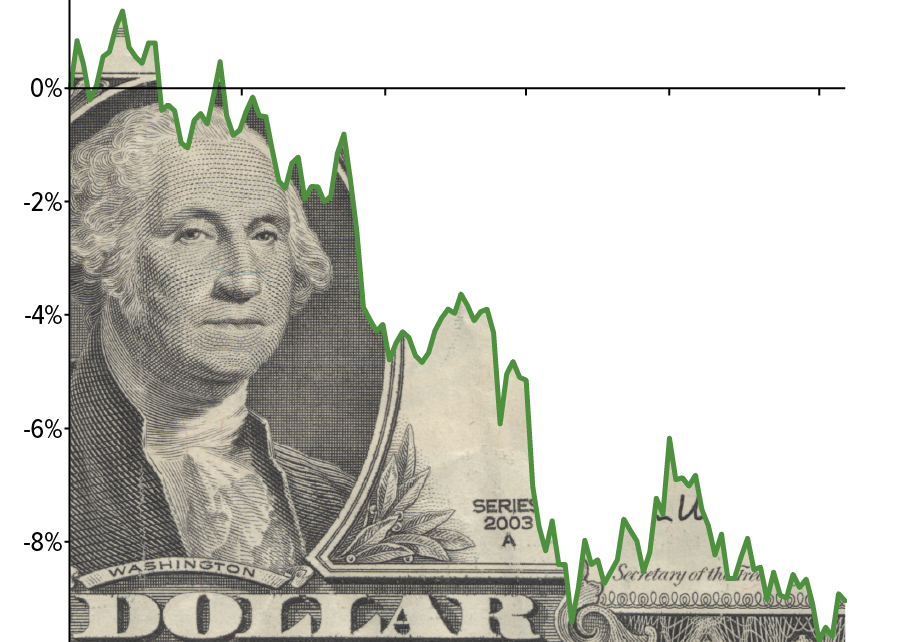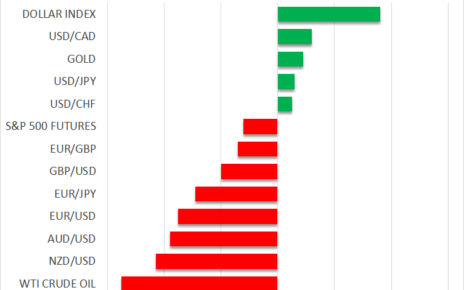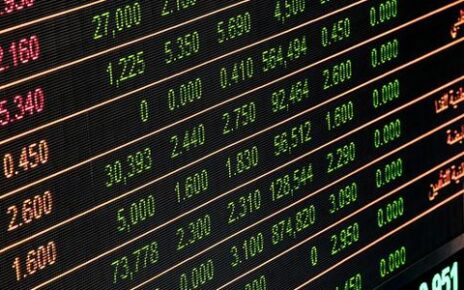The dollar index, measured against a basket of major currencies, has fallen about 10% year-to-date through mid-June and is trading at its weakest level in three years. This decline is not a minor wobble; it raises the prospect of further downside as concerns mount over the growing U.S. budget deficit and persistent turbulence in tariffs and trade policy. In a client note sent last week, UBS described the greenback as currently unattractive, suggesting it will continue to weaken as the U.S. economy slows. At the same time, reports indicate that foreign suppliers—from Latin America to Asia—are nudging U.S. importers to settle invoices in euros, pesos, and yuan to dodge currency swings. Against this backdrop, gold has emerged as a clear beneficiary of a weaker dollar, typically moving in the opposite direction to the U.S. currency. The asset’s price dynamics, central-bank buying, and broader de-dollarization trends outlined below collectively illustrate a shift in the global financial architecture.
The Dollar’s Decline and Global Currency Dynamics
The U.S. dollar’s retreat from its post-World War II prominence has been gradual but persistent, underpinned by a confluence of macroeconomic and geopolitical factors. The broad U.S. currency index has now retraced a sizable portion of its earlier gains, reflecting a combination of widening fiscal deficits, rising interest-rate differentials with other major economies, and shifts in international commerce that increasingly tolerate or even prefer non-dollar settlement. This is not merely a financial markets narrative but a structural development that could influence global trade, sovereign balance sheets, and how countries manage monetary policy amid a more multipolar financial system. While the dollar remains the dominant vehicle for global trade and nearly half of all international debt transactions, the momentum toward diversification has intensified in the past year, aided by political pressures, economic deceleration in the United States, and growing confidence in alternative currencies and assets.
The practical implications of a weaker dollar extend beyond currency markets into the day-to-day mechanics of international commerce. If importers and exporters increasingly price and settle trades in euros, yuan, or other currencies, exchange-rate risk could shift from producers to financial hedging strategies and treasury management. Firms may need to rethink financing structures, currency reserves, and the cost of cross-border operations. The dynamic is not just about the euro becoming more dominant; it is about a broader move toward a more tripartite or multi-currency environment in which the U.S. currency shares the field with other regional and local currencies that offer competitive advantages for particular trade corridors and policy goals. These shifts do not imply an immediate abolition of the dollar, but they do suggest a trend toward greater currency diversification in commercial transactions and reserves.
In this evolving landscape, investor strategies that previously assumed the dollar as a given may require recalibration. Currency hedging, cross-border financing considerations, and a nuanced understanding of how macroeconomic shocks may reverberate through different currencies will become more central to portfolio management. The evolving currency regime also interacts with inflation dynamics, monetary policy normalization paths in major economies, and global risk sentiment. As a result, market participants—from corporates to sovereigns to individual investors—are re-evaluating exposure to a single anchor currency and considering how best to balance potential upside in non-dollar assets with the inherent liquidity and depth of dollar-denominated markets.
The Role of Trade Settlement Shifts
A notable thread in the currency narrative is the push by some buyers and sellers to settle trades in non-dollar currencies. The intention behind this shift is to reduce exposure to dollar volatility and to diversify counterparty risk across a broader spectrum of currencies. In practice, this means increased use of the euro, yuan, and other regional currencies in both invoicing and payment flows for cross-border settlements. The trend reflects a combination of policy-driven efforts, financial infrastructure evolution, and commercial prudence in an era of heightened macroeconomic volatility. The move toward diversified settlements—whether on a bilateral basis or within regional blocs—could gradually erode the dollar’s unmistakable dominance in international trade finance, particularly among emergent economies seeking to insulate themselves from U.S. policy shocks and the unilateral risks that can accompany a heavy reliance on a single currency.
In parallel to settlement diversification, market participants are watching how exchange rates interact with global monetary cycles. If the dollar continues to soften relative to other major currencies, financial institutions may adjust their liquidity management practices, re-allocate reserve holdings, and rethink their exposure to dollar-denominated assets. For U.S. investors, these shifts can influence the relative attractiveness of U.S. equity and fixed-income markets, as well as the demand for inflation-protected securities, real assets, and foreign-denominated investments that can offer diversification benefits. The precise trajectory remains uncertain, but the underlying message is clear: the global monetary ecosystem is gradually becoming more pluralistic, with implications for currency markets, central-bank policy, and global portfolio construction.
Corporate and Sovereign Responses to a Weaker Dollar
As the dollar softens, corporates and sovereigns face a set of practical responses designed to optimize cost of capital and manage currency risk. For multinational corporations, a weaker dollar can affect revenue translation, pricing strategies in foreign markets, and competitive dynamics. Companies with substantial foreign earnings may experience favorable translation effects when converting back to the home currency, while those with large dollar-denominated liabilities could face higher costs if other currencies appreciate against the greenback. Conversely, commodity exporters priced in dollars might benefit from a stronger non-dollar currency in their own financial planning, as hedging costs and revenue streams become more complex in a shifting regime.
Sovereign balance sheets would also be expected to respond to sustained currency shifts. Accumulating financial assets in non-dollar denominations, diversifying foreign exchange reserves, and increasing the share of gold or other non-dollar reserves can serve as strategic hedges against dollar volatility. The broader point is that central banks and finance ministries around the world are increasingly considering a more diversified reserve framework, which may include a rising role for precious metals, sovereign wealth funds, and currency baskets that reflect regional economic realities. The confluence of policy choices, hedging strategies, and reserve diversification will shape the speed and texture of the de-dollarization trend over time.
Gold: The Anticipated Beneficiary of a Weaker Dollar
Gold has clearly benefited from a softer dollar, with the metal historically moving inversely to the greenback’s value. In today’s USD-denominated pricing environment, gold’s appeal as a store of value and crisis hedge remains intact even as monetary policy and inflation dynamics evolve. Market participants watch gold not only as a traditional safe-haven asset but also as a potential monetary-anchor alternative in a landscape of rising currency diversification and changing reserve allocation patterns. The price action of gold in recent periods—trading above a notable psychological level while remaining a touch below its former all-time peaks—reflects ongoing demand from both official sector buyers and private investors seeking hedges against currency risk, geopolitical uncertainty, and potential inflation pressures.
Central Bank Gold Purchasing and Official Holdings
One of the most compelling macro narratives has been the sustained growth in official gold purchases by central banks. In recent years, the official sector’s gold acquisitions have climbed to levels that resemble pre–Bretton Woods dynamics, underscoring a broad rebalancing of reserve portfolios away from a heavy reliance on paper currencies. The World Gold Council (WGC) reports that central banks’ official gold purchases have exceeded cumulative annual inflows of 1,000 metric tons for three consecutive years, a pace that surpasses the long-term average of the prior decade by a substantial margin. This pattern indicates a deep-seated preference for gold as a long-hallowed store of value and as a potential counterpart to the vulnerabilities of fiat currencies. The significance of these purchases is not merely ceremonial; they have tangible implications for market liquidity, price discovery, and the strategic posture of reserve managers globally.
The magnitude of official gold holdings in some regions — and the speed at which official actors have increased their gold reserves — has realigned market expectations about what constitutes a robust, diversified reserve portfolio. The data suggests that central banks are approaching levels of gold holdings that resemble historical highs seen during earlier monetary regimes. That shift has ripple effects for the broader financial system: higher gold demand from official sector buyers typically supports gold prices and can alter the risk calculus that informs currency and debt markets. In this context, gold’s role as a stabilizing asset within central-bank portfolios remains prominent, even as other reserve assets and fiat currencies compete for attention in increasingly complex macro landscapes.
The Euro vs. Gold in Global Reserves
A striking observation arising from central-bank behavior is a historic shift in the composition of global foreign-exchange reserves. For the first time in archival data, gold has overtaken the euro in share of global reserves, with gold accounting for about 20% of total official foreign-exchange assets and the euro around 16%. This reversal is notable because it signals a re-weighting within reserve portfolios in favor of a non-sovereign asset class that is not tied to a single country’s policy stance or currency. The implications for currency markets are significant: a rising gold weight may temper the pace of dollar-centric balance-sheet dynamics by offering a more universally accepted hedge that is not anchored to one country’s monetary policy. The phenomenon aligns with a broader sentiment among policymakers and market participants that gold can function as a stabilizing asset during episodes of geopolitical risk or policy misalignment.
The 95% Central-Bank Expectation to Increase Gold Reserves
The European Central Bank (ECB) has highlighted a historical trend supported by recent empirical surveys: a vast majority of central banks anticipate increasing their gold holdings in the coming year. The World Gold Council’s latest survey indicates that about 95% of central banks expect to raise their gold reserves in the next 12 months, marking the highest proportion since the survey’s inception. This near-consensus expectation reinforces the view that gold remains a preferred instrument for diversification and risk management within official portfolios. The confluence of elevated demand from the official sector, the relative stability of gold as a store of value, and the ease with which gold can be held domestically in some jurisdictions creates a compelling macro narrative about intended reserve posture shifts over the near term. Taken together, these indicators point to a sustained and perhaps accelerating preference for gold in official asset allocations, even in the face of fluctuating gold prices.
Regions Leading Gold Purchasing and De-Dollarization Efforts
South-South economies have emerged as primary drivers of new gold acquisitions, with several nations in the Global South expanding their official gold reserves in recent years. Nations including Turkey, India, China, and Brazil have all added to their gold holdings in the pursuit of a more resilient and diversified reserve framework. The narrative here is not solely about bullion accumulation; it reflects a broader strategic attempt to reduce reliance on dollar-dominated financial infrastructure and to increase autonomy over monetary policy and external financing. The driver is a mix of policy initiative, financial pragmatism, and a recognition that bullion may offer a safeguard against currency devaluation and external shocks that could hamper economic stability. This trend also signals a potential reconfiguration of monetary leadership, with the Global South playing an increasingly prominent role in how the world’s monetary order evolves.
Asia’s Regional Integration and Local-Currency Settlement
A notable strategic development in Asia—and indeed in the broader regional context—is ongoing efforts to reduce dollar dependence in regional trade and payments. Reports from CNBC and other outlets indicate that ASEAN member countries are implementing regional plans to expand the use of local currencies for a growing share of cross-border transactions. This shift is designed to strengthen regional financial integration, lower currency exposure, and foster more predictable commercial terms among trading partners within Southeast Asia and beyond. The push toward local-currency settlement aligns with broader de-dollarization dynamics by providing practical mechanisms for reducing the need to convert into dollars for trade, thereby mitigating exchange-rate volatility and transaction costs for regional businesses.
In tandem with these trade-finance reforms, China has been actively expanding its cross-border payment network, the Cross-Border Interbank Payment System (CIPS), which offers a yuan-denominated alternative to the SWIFT network for settling international transactions between banks and financial institutions. The CIPS framework is designed to facilitate yuan-based settlements on a broader, more global scale, contributing to a more diversified payments ecosystem. This month, China announced the addition of six foreign banks to the CIPS network, expanding its presence into Africa, the Middle East, and Central Asia. The expansion signals a strategic intent to embed the yuan deeper into international financial flows and to provide non-dollar settlement rails that can support broader de-dollarization ambitions. The interplay between regional currency use, swap lines, and the growing reach of CIPS represents a tangible, institutionally grounded pathway toward a more multipolar monetary order.
The Asia-Pacific Path Toward a More Multipolar Financial System
The Asia-Pacific region’s push toward de-dollarization is not solely about technical settlement infrastructures; it also reflects a broader desire to insulate regional economies from external policy shocks and to foster financial resilience through diversification. Local currency financing, currency swap arrangements, and the expansion of non-dollar payment rails all contribute to a regional financial architecture that can accommodate a wider set of currencies in daily transactions. These developments are particularly salient for economies with large trade volumes and robust growth prospects, as they seek to preserve competitiveness while maintaining macroeconomic stability in a more uncertain global environment. The cumulative effect of these measures is to gradually reduce the centrality of the dollar in Asia’s commercial and financial life, while also offering pathways for other regions to build parallel structures that complement the existing dollar-centric system.
Sanctions, Geopolitical Risk, and the Insurance Value of Gold
The geopolitical shocks of recent years have underscored the fragility of the dollar-centric model, particularly in the face of sanctions and political risk. Since Russia’s invasion of Ukraine in 2022, Western sanctions have highlighted the potential vulnerabilities of concentrated dollar assets and the exposure of certain financial instruments to policy actions. In the European context, the ECB notes that the trend toward gold accumulation as a strategic reserve response aligns with the desire to reduce exposure to currency and policy risks associated with fiat assets. In one sense, gold provides a form of geopolitical insurance: sovereigns can mitigate the risk of sanctions, asset freezes, and disruptions to access to payment corridors by holding a tangible, portable, and widely recognized store of value. In contrast, claims on Treasuries and other dollar-denominated assets can become compromised or constrained in extreme political scenarios, whereas physical gold and gold-backed assets offer a form of resilience that is less vulnerable to policy-based asset seizures or prohibitions on cross-border transfers.
A practical implication of this geopolitical calculus is the recognition that gold’s role in a portfolio can extend beyond traditional inflation hedging. For many emerging-market economies and for diversified reserve managers, gold constitutes a form of strategic fortification that complements other assets, including foreign currencies and sovereign debt instruments. The capacity of gold to act as a hedge against systemic risk, and its potential to maintain value under conditions of financial isolation or sanctions, reinforces its appeal as a resilient asset class within a broader risk-management framework. This perception helps explain the sustained interest in gold from both official and private-sector actors who seek to balance currency exposure with the stability and universality of a bullion asset.
Implications for U.S. Investors and the 10% Gold Allocation Principle
Despite the stronger tailwinds for gold and the broader trend toward de-dollarization, the U.S. dollar is unlikely to vanish in the near term. It remains dominant in global trade and the international debt market, and it continues to anchor many major financial transactions around the world. However, the balance of power is shifting gradually, with visible signs of diversification in official portfolios and increased interest in non-dollar settlement mechanisms. For U.S. investors, this evolution implies reassessing exposure to a single currency and considering how to build resilience against potential currency shocks, inflation, and geopolitical risks that could affect investment performance and liquidity.
A practical takeaway for many investors is the so-called 10% Rule of Gold: consider allocating roughly 10% of a diversified portfolio to gold and gold-related assets. The recommended split suggests allocating about 5% to physical gold bullion and 5% to high-quality gold mining equities. This allocation seeks to balance the tangible, downside-protected characteristics of physical gold with the growth potential and leverage offered by well-managed gold miners. The logic behind this guideline is to provide a hedge against currency and inflation risk, diversify away from a single fiat currency, and capture upside potential from the precious metals’ sector as it responds to global macro shifts. It is important to approach such a allocation with disciplined risk management, regular portfolio reviews, and an awareness that gold prices can experience volatility in the short term even as longer-term reserve and hedging themes remain intact.
In evaluating investment options, it is essential to recognize that macroeconomic conditions and policy directions can change rapidly. While gold offers a historically strong hedge and store-of-value function, it does not generate yields in the same way as some income assets, and its price is influenced by a wide range of factors including monetary policy expectations, exchange rates, and demand from central banks and investors. Therefore, any allocation should be positioned within a broader asset-allocation framework that reflects individual risk tolerance, time horizon, and liquidity needs. Investors should seek professional financial advice to tailor their approach to their specific circumstances and to ensure that any allocation to gold is consistent with their overall investment strategy and financial goals.
Market Sentiment and Caution
As with any investment guidance, it is important to approach gold allocation with a balanced view. While central banks’ ongoing interest in gold supports its long-term case, the price of gold can experience volatility due to shifts in monetary policy expectations, shifts in risk appetite, and changes in sovereign holdings. Individuals and households may consider small, incremental adjustments to exposure rather than large, abrupt reallocations, ensuring that their broader financial plans—including retirement funding, education, and emergency savings—remain secure. The landscape ahead is characterized by a mix of policy uncertainty, currency diversification, and the ongoing evolution of international financial infrastructure. Investors who remain adaptable and informed will be best positioned to navigate a world in which the dollar’s dominance remains, but where diversification and hedging take on greater importance than in the recent era of dollar supremacy.
The Path Forward: Policy Outlook, Risks, and Opportunities
Looking ahead, the global monetary and financial order is likely to remain in a phase of gradual adjustment rather than abrupt upheaval. Policy makers will need to balance growth, inflation, and financial stability considerations while also addressing the systemic risks associated with high levels of debt and currency volatility. The de-dollarization trend is likely to persist, supported by structural changes in payments infrastructure, regional currency integration, and strategic reserve diversification. However, the dollar’s multifaceted role in global finance will continue to confer a degree of resilience, even as other currencies and assets gain traction in particular regions and sectors. The coming years could see a more multipolar reserve system, with greater emphasis on gold, regional currencies, and diversified payment networks as counterweights to the traditional dollar-centric framework.
Investors should remain attentive to shifts in central-bank behavior, commercial hedging practices, and the evolving architecture of international trade finance. The interconnections among these elements will shape currency trajectories, commodity prices, and the relative performance of non-dollar assets. For individuals building long-term wealth, a thoughtful approach to diversification—especially through exposure to physical gold and quality gold equities—can complement traditional holdings in equities and fixed income. The overarching message is one of prudence, diversification, and informed decision-making in a world where the dollar’s dominance is undeniable but increasingly contested by a broader spectrum of currencies, assets, and financial technologies.
Conclusion
The landscape surrounding the U.S. dollar, gold, and global reserve diversification is undergoing a meaningful transformation. The dollar has not disappeared, but its leadership is being tempered by rising international interest in alternative currencies, new settlement rails, and a robust appetite for gold as a strategic reserve asset and hedging instrument. Central banks around the world have increased gold holdings, and the market’s structure appears to be embracing a more multipolar framework where gold and local currencies play a greater role in reserve diversification and cross-border settlements. In this environment, U.S. investors should consider building resilience through prudent diversification, mindful currency exposure, and a measured allocation to gold as part of a balanced, long-term strategy. The era of single-currency dominance may be evolving toward a more nuanced, multi-currency, multi-asset approach to financial stability and wealth preservation.



